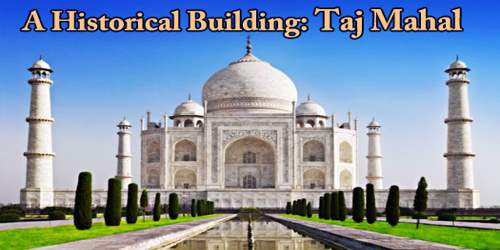The Taj Mahal (/tɑːdʒ məˈhɑːl, ˌtɑːʒ-/; lit. ’Crown of the Palace’, taːdʒ ˈmɛːɦ(ə)) is an enormous mausoleum complex commissioned in 1632 by the Mughal emperor Shah Jahan to house the remains of his beloved wife. Constructed over a 20-year period on the southern bank of the Yamuna River in Agra, India, the famed complex is one of the most outstanding examples of Mughal architecture, which combined Indian, Persian, and Islamic influences. At its center is the Taj Mahal itself, built of shimmering white marble that seems to change color depending on the daylight. Designated a UNESCO World Heritage site in 1983, it remains one of the world’s most celebrated structures and a stunning symbol of India’s rich history. The Taj Mahal stands on the south bank of the Jamuna at Agra. It was built by the Mughal Emperor Shah Jahan in memory of his beloved wife, Mumtaz Mahal. It took twenty thousand workmen, twenty-two years to complete the building. The Taj Mahal is made of pure white marble. It has four minarets at each end and a big dome at the center. The main building stands over a basement in a rectangular shape. The remains of Shah Jahan and Mumtaz Mahal lie buried under it. There is a park in front of it. The fountains and multi-colored flowers add to the beauty of the palace.
The Taj Mahal is built on the design traditions of Persian and earlier Mughal architecture. Mainly the inspiration came from successful Timurid and Mughal buildings including the Gur-e Amir (the tomb of Timur, a progenitor of the Mughal dynasty, in Samarkand), Humayun’s Tomb, Itmad-Ud-Daulah’s Tomb (sometimes called the Baby Taj), and Shah Jahan’s own Jama Masjid in Delhi. Earlier Mughal buildings were primarily constructed of red sandstone. Shah Jahan preferred the use of white marble with semi-precious stones. Buildings under his encouragement reached new levels of refinement. The materials used to make this monument, are derived from various sources. Mainly White stones were brought from Nagrar based Makrana and red stones were recommended from Dhaulpur and Fatehpur Sikri. Yellow and black stones were erected from Nirbad and Charakoh. Some precious stones and gold and silver items were procured from some prominent emperors and from abroad. Some goods were also imported from far-flung areas. There is different opinion among historians about the cost incurred on the construction of the Taj Mahal. Some historians say that Rs 3 crore was spent in the construction of the Taj Mahal at that time.
The Taj Mahal looks wonderful in the crimson rays of the setting sun. It attracts a large number of visitors every day from home and abroad. On a full moonlight, the Taj Mahal looks very grand and magnificent. Its beauty surpasses all description. The visitors watch with wonder and admiration of the grandeur of the building. They drink deep into its beauty. Each historical site has its own importance. The significance of the Taj Mahal is in its architectural craft and beauty, which has made it unique. In addition, the love of Shah Jahan has made a successful attempt to infuse life in this beautiful building. By seeing the Taj Mahal, the lovers themselves sing songs of love.
















